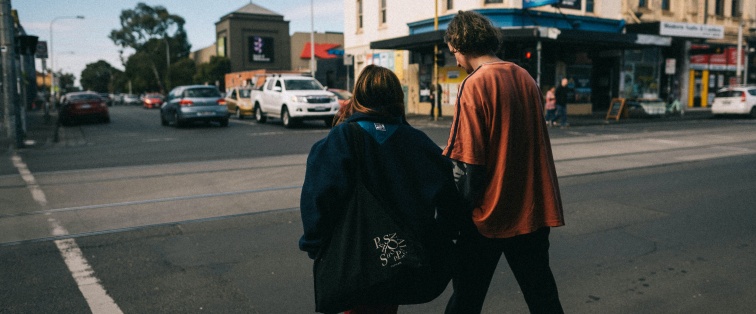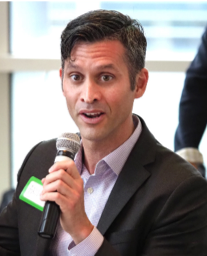Three Philadelphia Viewpoints on Teens and Mental Health

Editor’s Note: PolicyLab’s communications team is interested in learning more about our blog readers and your thoughts on our content. We invite you to take this 5-minute survey to help us ensure our posts continue to be helpful and relevant to our readers. The survey will be open until May 1, 2019.
Teen Health Week offers an exciting opportunity to focus on the unique health issues that teens face worldwide. I’m thrilled to take part in this conversation and feel like I have a great opportunity to do so in my new role as PolicyLab’s behavioral health strategy manager. In this position, I work with our incredible researchers to shape the strategic direction of our behavioral health research and policy work.
If we approach behavioral health from a purely epidemiological perspective, we know that anxiety and depression top the charts in terms of mental health impacts for adolescents and that suicide is now the second leading cause of death among teens. This information alone should garner the attention of researchers, communities, policymakers and funders. My passion is in bridging these worlds, and I believe that cross-system collaboration is key in accomplishing a meaningful impact in any of these areas. In honor of Teen Health Week’s Philadelphia roots, I want to focus on the behavioral health issues impacting adolescents from a local perspective. I thought it would be fitting to engage with thought leaders from across our city, so I asked each of these leaders the following three questions. I hope you find their answers as enlightening as I did for the future well-being of the city’s youth.
- From your perspective, what is the number one behavioral health issue facing adolescents in Philadelphia?
- How are you prioritizing this issue in the work that you do?
- What will it take to move the bar in this area?
 Kamilah Jackson, MD, MPH, deputy chief medical officer for children’s services at Community Behavioral Health:
Kamilah Jackson, MD, MPH, deputy chief medical officer for children’s services at Community Behavioral Health:
1) At the local level, I believe you cannot talk about adolescent mental health without highlighting comorbidity and the impact of trauma. When we talk to members of our youth advisory board, they highlight witnessing violent incidents as well as experiencing interpersonal violence as a key area of concern. People frequently think about the physical changes of adolescents and attribute emotional changes to being moody or “hormonal.” However, the data tells us that most adult mental health disorders have their origins in adolescence and in fact, half of all mental health problems begin by age 14. In general, I think that raising awareness about the importance of promoting positive mental health in adolescents and giving value to their experiences in the same way we would to physical health concerns is critical given the importance of this stage of development, especially when you consider the link between mental health and overall health outcomes.
2) As a public behavioral health funder, one of our greatest achievements has been in our long-standing commitment to supporting the implementation of evidence-based treatments. Cognitive therapy has been promulgated across our provider network through a robust public-academic partnership with the University of Pennsylvania, and is a foundational approach particularly when addressing depression and anxiety. I’m also proud of our work with the Philadelphia Alliance for Child Trauma Services grant, which is aimed at providing the most effective treatments for traumatized youth and their families. Additionally, we partner and fund programs in Philadelphia schools in support of children and families in the child welfare system, in Federally Qualified Health Centers and in primary care. There are too many efforts underway to mention them all, but I’d be remiss not to also mention our work with Youth MOVE which is meant to enhance youth voice and uses youth peers to make an impact in this area. We are also increasing our efforts around supporting caregivers. We know adolescence is a period of separating from and developing an identity outside of a young person’s family, but the importance of family support and the encouragement of caring adults cannot be underestimated.
3) We need to focus efforts on creating opportunities for supporting overall wellness, which includes educating adults who interact with young people about how to provide environments that tend to their social and emotional needs and assist them in navigating this tricky period of development. If we think back to our own adolescence, many of us can often identify that one adult whether parent, teacher, coach or other adult who seemed to care and who had a positive impact on our development. However, far too many of our young people are not able to complete an education or find employment, which is one of the major developmental tasks of this time period. Their experiences with interpersonal violence and trauma also impact their ability to develop healthy relationships. The level of poverty, violence and unemployment in our urban centers is daunting, but our young people are incredibly resilient and we can collectively do more to further promote their ability to overcome some of the challenges they face to make their way successfully into adulthood. The solutions lie in traditional support structures as well as ones we may not think of such as vocational skill building, recreational outlets and general supports for the family structure. If teens cannot see a future for themselves, it can easily lead to decreased mood, anxiety and helplessness.
Laura Morris, LSW, operations director of community-based prevention services at the Department of Human Services (DHS): 
1) The number one behavioral health issue I see facing adolescents is trauma. We are bombarded daily with concerns about safety—not just physical safety, but emotional safety as well. Many of us are recovering from traumatic events and adolescents are no different. Youth are told they are moody, impulsive or distracted when they may just be responding to trauma and seeking ways to cope.
2) One of the best things about being on the DHS Prevention team is that we live by our mission and values. We want adolescents and their families to be strong and develop through the community-based programming we support. DHS Prevention invests in numerous programs and services that are trauma-informed in their approaches. Our Education Support Center programs help youth with truancy issues to identify the barriers they are facing in order to find ways to achieve their educational goals. Our investment in domestic violence and interpersonal violence programs includes specialized services to adolescents who may be in an unhealthy relationship or have witnessed domestic violence at home. We have numerous positive youth development programs throughout the city that are engaging youth every day in career development, leadership and mentoring. Engaging adolescents in effective programming is an intervention in my eyes. Our program staff listen and respond to youth experiencing trauma symptoms and often provide the bridge to treatment and recovery.
3) Overall, we need to conquer vulnerability and have effective trauma treatments made more readily available. Suicide is the second leading cause of death for young people ages 10-24. Online groups like TheMighty, It Gets Better and the Foundation for Suicide Prevention are helpful when working with youth, but nothing can replace effective treatment with a trauma trained professional.
 Arturo Zinny, LPC, program director at Drexel’s Healing Hurt People, and Laura Vega, DSW, LCSW, violence prevention supervisor at Children's Hospital of Philadelphia's Violence Intervention Program, have joined
Arturo Zinny, LPC, program director at Drexel’s Healing Hurt People, and Laura Vega, DSW, LCSW, violence prevention supervisor at Children's Hospital of Philadelphia's Violence Intervention Program, have joined  forces to share their perspectives on how community violence impacts adolescent mental health:
forces to share their perspectives on how community violence impacts adolescent mental health:
1) Exposure to trauma is a leading issue among adolescents living in Philadelphia. The impact of poverty, racism and community violence all contribute to this epidemic and increase the risk for negative psychosocial outcomes. The youth we see experience high rates of post-traumatic stress symptoms and many of our youth present with nightmares, trouble sleeping, lack of concentration and hypervigilance, which deeply affects their safety, education and overall health.
2) Trauma is prioritized in everything we do. Our work focuses specifically on violence intervention programming that is intended to wrap services around the whole family recognizing that siblings and caregivers are also impacted by trauma. This addresses imminent safety concerns to reduce retaliation and re-injury while helping families navigate systems of care and facilitate healing.
3) We are both strong believers that change is possible, but it will take a major paradigm shift in policies that continue to create disparities between those of privilege and those without. From what we learned from the Adverse Childhood Experiences study, we should be targeting funding toward intervening as early as possible in a child’s life to prevent the impact of early trauma. We should invest in creating socially just systems that understand the impact of trauma and address the structural barriers that continue to oppress children and families. We also need to fund research that promotes the evidence base for effective, culturally competent trauma treatments for youth and families experiencing complex trauma.
Did you notice that each of these perspectives highlight the need for continued collaboration in this area? Teens move through many transitions, all of which can be particularly challenging for those experiencing multiple stressors such as poverty, exposure to community violence and mental health concerns, but with influential, valuable partners and our deep bench of behavioral health expertise here at PolicyLab, we hope to continue to make contributions that move the bar forward for this important population.
Shawna Dandridge, LCSW, is a former policy and strategy manager at PolicyLab.

